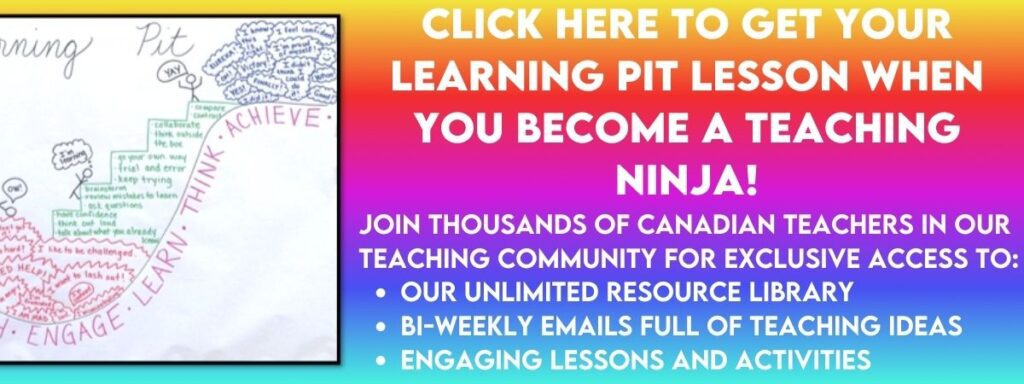
Have you been learning about growth mindset and wanting to try to instill some determination in your students? Have you heard of the learning pit? It might be the key to teaching students to learn how to learn.
Do you have students that break down during tasks that require a bit of problem-solving? Are they frustrated? Do they yell and scream or run out of the classroom? You need the learning pit.
Teaching students to overcome challenges can be difficult when we live in a society that is all about getting things done quickly. We have technology, parents and constant distractions constantly telling students they can learn anything anytime with little or no effort. As a teacher, this is very challenging when students feel they’ve failed, get frustrated or give up right away.
This was what was happening in our classroom. Students who could manage challenges were more successful overall because they kept working until they got it. It felt like it was a lack of effort, but it was much more than that. So we started investigating and researching best practices to help us teach students to become comfortable with being uncomfortable.
Let’s Start at the Beginning With Growth Mindset

You’ve likely heard of Carol Dweck’s work on Growth Mindset and while her work definitely aligns with our goals, this post actually starts with Facebook. Yup, a friend posted a video on Facebook and it led us on this journey.
Let’s set the stage. We were teaching a grade 4/5 combined class with 29 students of all different abilities. Basically, we were teaching students across five different grade levels when you put in all the special modifications and adaptations being made to reading and math.
We were burning out fast.
But then we started looking for ways to teach our students to work through problems instead of immediately coming to ask for help (which wasn’t possible and often led to students standing in a big line wasting all their time not working) or they would shut down completely and not only would the lesson be a loss, but half the day would be gone dealing with outbursts.
We were ready to pull our hair out.
And then a friend posted this video. And the light bulb went off. What if we shared this information with students in a way they could understand? Would it help students learn to solve their own problems and try to complete their work on their own before coming to seek help?
Spoiler alert, it totally helped. And we want to help you too.
You can watch the video right here.
What does the research say about the learning pit and growth mindset?

It is based on the work of James Nottingham and you MUST visit his site. He discusses four main steps in the learning process.
Concept: The material in which students are familiar but have not mastered.
Conflict: Create an intentional cognitive conflict which will allow students to build a Growth Mindset.
Construct: Teach students skills, tools and methods to overcome the challenge and thus master the concept.
Consider: Have students reflect on the steps they took to resolve the conflict and consider new ways to use the information they’ve acquired.
So what does the learning pit look like in our classroom?
We designed a lesson around teaching this information to students.
We started with a difficult STEM challenge. It happened to be from our Electricity STEM Challenges, but it could be ANY difficult concept from long division to this free fun activity we’ve also used. Find the Electricity STEM Challenges in our TpT Store ($USD) and BN Shop ($CAN).
Don’t tell students that you’re going to make them struggle the first time you introduce this concept. Give them the activity and don’t overly explain or teach them what to do (this is the cognitive conflict). While they work, collect words or phrases you hear that relate to the conflict.
We have an entire post written about how critical thinking tasks that make kids face challenges benefit their learning. You should check out that post.
Ninja Note: If you have students who are going to freak out beyond anything, consider letting them in on the activity. Give them a heads-up about what is going to happen.
Bottom of the Pit
These are some of the conflict words or phrases that go in the bottom of the pit:

- I don’t get it.
- This is so hard!
- I like to be challenged, but this is hard.
- I’m confused.
- I’m angry.
- I am frustrated.
- I am mad.
- This is so frustrating.
- I’m sad that I don’t get it.
- I don’t understand.
- Help me.
- I need help.
- I want to lash out.
- I’m out of ideas.
- This is impossible.
Stop the activity you’ve given students and tell them you’ve intentionally made it difficult for them. Draw a big pit on a large piece of paper. We made ours on butcher block-style paper running along an entire wall. Write the conflict words at the bottom of the pit. Ask students to give you other words they thought of when they were working. Add to these as you work through the school year as students will come up with more once they know what they are looking for.
Give students enough information to lead them to discover the answer. Listen to and record these words as they are saying them. Add these words at the top of the pit (on the right side). Brainstorm other words that might fit into this category with the class.
The most unexpected result was when students said they liked the feeling of “getting it.” We explained the role of teachers is to help students feel that they “get it.” From then on, our class agreed we needed to be careful not to take the “getting it” feeling away from each other.
Top of the Pit
On the top out of the pit (write these on the right side at the top). These are words or phrases that students might say or feel when they figure something out:
- Eureka!
- I know this!
- Finally!
- Victory!
- I didn’t think I could do it.
- Great!
- I’m so happy!
- I feel so confident.
- I know this is right.
- Oh!
- I got it!
- I did it!
- Yes!
- I can do this!
- It’s not hard once you understand how to do it.
Between the bottom of the pit (conflict) and top (consider) brainstorm with students words or phrases that help them construct understanding. We turned these into steps, but you could also draw a ladder. This is to represent the steps you need to take to work through a difficult task. We talked about all the ways they learned to do things like modelling, researching and asking good questions. Most of these terms were given to students by us. We kept adding as the year went on.
Leading Out of the Pit
Draw a set of stairs that lead the way out of the pit. On the stairs write words or phrases that help get people thinking about a way out of the pit:
- Let’s brainstorm some ideas.
- What task/project/book is like this?
- Collaborate
- Think outside the box.
- Compare or contrast
- Use what you already know.
- Sort out what you know from what you don’t know.
- Ask good questions.
- Watch how to do it.
- Keep trying.
- Try something new.
- Trial and error.
- Go your own way.
- Talk out loud.
- Act it out.
- Review past mistakes.
- Stay confident.
Finishing Details for the Pit

We finished off our Learning Pit mural by adding a title, keywords under the pit that reflect learning and some stick figures to represent students moving through the journey just for fun.
As our school year progressed, we continually added to the pit and some students even made pits of their own.
We realize our photo is a little challenging to read, so we’ve made an entire lesson for the learning pit. It walks you through all the steps, lists all the possible phrases and has examples for you. The lesson is available in our Resource Library or we can send you a copy when you sign up for our mailing list.
If you are looking for another activity to help reinforce the concept of The Learning Pit, we recommend trying out our Learning Pit Drama Circle. It is a more structured activity that you can use to build on what students have learned with you. You can find it in our TpT Store ($USD) or our BN Shop ($CAN).
So did it work? The process of building the pit took one week. We spread out the activities a little bit at a time, but over the course of the week, we did five different challenges and kept adding to our mural.
From that point on, whenever we knew the new concept or activity was going to challenge students we would tell them “We’re throwing you in the pit!” When students were struggling they would tell us they were in the pit. Having a common language for us all to use made everyone feel better.
Do you still need to be convinced about why you should try the learning pit for growth mindset?
A Parent Email
One of the best things was receiving an email from a parent asking what the heck this pit their child was talking about all the time. We think they might have thought it was a real pit.
Student-Led Conferences Eavesdropping
When we had our student-led conferences it was so great to hear our students explaining the mural and how we made it to their parents. They had become experts on the learning pit and knew exactly how to teach all about it.
Helicopter Parent Tip
This was SHOCKING news to some parents. One particular student told his mom that by doing everything for him, he was missing out on being in the pit and wanted to be left to try things on his own once and while. His mom came to talk to us and thanked us for giving their family a language starting point. He’d used the pit to convince his parents to give him more responsibilities. He got to start walking to school without his mom and was allowed to make his own lunches for school. Talk about a growth moment!
Another Parent Conversation
A grandparent came to the student-led conferences and made a comment to us, “We didn’t need to learn about this kind of stuff when we were in school. It seems like a waste of time.” Well, before we could respond, the granddaughter of this person took the words right out of our heads, “Well gramma, things change. When you were a kid smoking was healthy. Now we learn about how to learn better because we have Google and can look stuff up.”
Our Students Became a Whole New Class
It was amazing to see the change in so many of our students. They enjoyed the challenge. Students who got out of the pit easily asked to be put back in with other more difficult challenges and students learned to respect that people get out of the pit at different speeds and with different tools. Tears of frustration were mostly gone (no one’s perfect) and we didn’t have to sacrifice valuable learning time chasing students who bolted from the classroom.
It worked so well, that we’ve used it with our classes year after year. Our only regret: not trying it sooner.
If you’re looking for another way to talk about growth mindset, there is a quote by Albert Einstein that comes to mind: A person who never made a mistake never tried anything new. We turned the quote into a collaborative poster. Find it in our TpT Store ($USD) or our BN Shop ($CAN). There is also a quote by Nelson Mandela: It always seems impossible until it’s done. Find it in our TpT Store ($USD) or our BN Shop ($CAN).
And as a bonus, teachers in our school started using our lesson and creating their own pits. It was so impressive to have a common language across the whole school.
What are your thoughts? Have you tried something similar? What else do you want to know about our journey? Let us know in the comments below. And until then, we hope you spend a little time in the pit!







